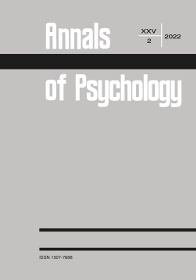Self-Esteem and Communication in the Perception of Women After the First and Subsequent Childbirth
Abstract
The aim of the research is to increase the knowledge of self-esteem and quality of communication in marriage in women after childbirth, taking into account the number of their children. The research group included 95 women after childbirth who completed the authors’ own sociodemographic questionnaire and two psychological standardized measures, the Rosenberg Self-Esteem Scale (SES) and Marriage Communication Questionnaire by Kaźmierczak and Plopa. It was found that self-esteem proved to be a positive predictor of perceived support and commitment provided by the partner only among mothers of two or more children, whereas in single mothers perceived support did not depend on the woman’s self-esteem. At the first birth, the support from the partner is not related to the mother’s level of self-esteem.
References
Battistich, V., Solomon, D., & Delucchi, K. (1993). Interaction processes and student outcomes in cooperative learning groups. The Elementary School Journal, 94(1), 19–32. https://doi.org/10.1086/461748
Baumeister, R. F., Campbell, J. D., Krueger J. I., & Vohs, K. D. (2003). Does high self-esteem cause better performance, interpersonal success, happiness, or healthier lifestyles? Psychological Science in the Public Interest, 4(1), 1–44. https://doi.org/10.1111/1529-1006.01431
Brown, J. D., & Marshall, M. A. (2006). The three faces of self-esteem. In M. H. Kernis (Ed.), Self-esteem issues and answers: A sourcebook of current perspectives (pp. 4–9). Psychology Press.
Campbell, J. D., & Fehr, B. (1990). Self-esteem and perceptions of conveyed impressions: Is negative affectivity associated with greater realism? Journal of Personality and Social Psychology, 58(1), 122–133. https://doi.org/10.1037//0022-3514.58.1.122
Campbell, J. D., & Lavallee, L. F. (1993). Who am I? The role of self-concept confusion in understanding the behavior of people with low self-esteem. In R. F. Baumeister (Ed.), Self-esteem: The puzzle of low self-regard (pp. 3–20). Plenum.
Dzwonkowska I., Lachowicz-Tabaczek, K., & Łaguna M. (2008). Samoocena i jej pomiar. Polska adaptacja skali SES M. Rosenberga. Podręcznik [Self-esteem and its measurement. Polish adaptation of the SES scale by M. Rosenberg. A textbook]. Pracownia Testów Psychologicznych.
Fagan, J., & Palkovitz, R. (2019). Coparenting and father engagement among low-income parents: Actor–partner interdependence model. Journal of Family Psychology, 33(8), 894–904. https://doi.org/10.1037/fam0000563
Gwiazdowska-Stańczak, S., & Sękowski, A. E. (2018). Rodzina uczniów zdolnych [Families of gifted pupils]. Difin.
Kaźmierczak, M., & Plopa, M. (2008). Kwestionariusz Komunikacji Małżeńskiej. Podręcznik [The Marital Communication Questionnaire. A handbook]. Vizja Press & IT.
Khaled, M., Corner, G. W., Horton, K., Khoddam, H., Stoycos, S., & Saxbe, D. E. (2020). Prenatal relationship conflict behavior predicts childbirth experiences and birth outcomes. Journal of Family Psychology, 34(6), 759–765. https://doi.org/10.1037/fam0000650
Kuo, P. X., Volling, B. L., & Gonzalez, R. (2017). His, hers, or theirs? Coparenting after the birth of a second child. Journal of Family Psychology, 31(6), 710–720. https://doi.org/10.1037/fam0000321
Kuo, P. X., Volling, B. L., & Gonzalez, R. (2018). Gender role beliefs, work–family conflict, and father involvement after the birth of a second child. Psychology of men & masculinity, 19(2), 243–256. https://doi.org/10.1037/men0000101
Lachowska, B. (2012). Praca i rodzina – konflikt czy synergia? [Work and family—conflict or synergy?]. Wydawnictwo KUL.
Le, Y., McDaniel, B. T., Leavitt, C. E., & Feinberg, M. E. (2016). Longitudinal associations between relationship quality and coparenting across the transition to parenthood: A dyadic perspective. Journal of Family Psychology, 30(8), 918–926. https://doi.org/10.1037/fam0000217
Louise, E., & Bradley, E. (2018). Co się dzieje z tym dzieckiem? Interwencje psychoanalityczne w pracy z rodzinami małych dzieci [What is happening to this child? Psychoanalytic interventions in working with families of young children]. Oficyna Wydawnicza Fundament.
Margolis, R., & Myrskylä, M. (2015). Parental well-being surrounding first birth as a determinant of further parity progression. Demography, 52(4), 1147–1166. https://doi.org/10.1007/s13524-015-0413-2
Marsh, H. W. (1996). Positive and negative global self-esteem: A substantively meaningful distinction or artifactors? Journal of Personality and Social Psychology, 70(4), 810–819. https://doi.org/10.1037/0022-3514.70.4.810
Plopa, M. (2008). Więzi w małżeństwie i rodzinie [Relationships in marriage and family]. Impuls.
Rosenberg, M. (1965). Rosenberg Self-Esteem Scale (RSES). https://doi.org/10.1037/t01038-000
Sękowski, A. E., & Gwiazdowska-Stańczak, S. (2018). Communication in the families of high-achieving students. Polish Psychological Bulletin, 49(4), 424–431. https://doi.org/10.24425/119511
Slade, A. (2005). Parental reflective functioning: An introduction. Attachment & Human Development, 7(3), 269–281. https://doi.org/10.1080/14616730500245906
Song, C., Benin, M., & Glick, J. (2012). Dropping out of high school: The effects of family structure and family transitions. Journal of Divorce & Remarriage, 53(1), 18–33. https://doi.org/10.1080/10502556.2012.635964
Zerle-Elsäßer, C., & Gniewosz, G. (2021). Linking mothers’ well-being to a subsequent birth: The mediating role of coparenting and personal income. Journal of Family Psychology, 35(3), 366–376. https://doi.org/10.1037/fam0000789
Copyright (c) 2022 Annals of Psychology

This work is licensed under a Creative Commons Attribution-NonCommercial-NoDerivatives 4.0 International License.


